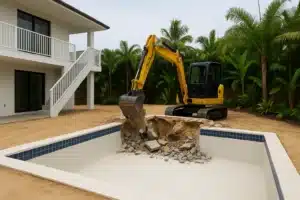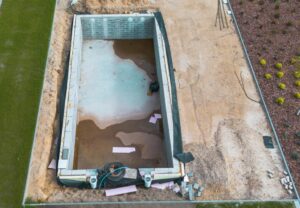Are you frustrated by those stubborn black spots that just won’t go away, no matter how much you scrub? Have you spent countless hours and hundreds of dollars on pool chemicals, only to watch those black patches return within days? Perhaps you’re worried about your family swimming in a pool that doesn’t look completely clean, or you’re embarrassed to invite friends over for a pool party. If any of these problems sound familiar, you’re likely dealing with black algae – one of the most persistent and challenging problems fibreglass pool owners face.
Don’t worry, you’re not alone in this struggle. As the experts at Jam Pool Removals, we’ve helped hundreds of pool owners just like you overcome their black algae nightmares. We understand the frustration of watching your beautiful fibreglass pool become riddled with these spots and the confusion that comes with trying countless treatments that promise results but don’t deliver.
In this guide, we’ll cut through the confusion and share our professional insights on exactly how to identify, treat, and prevent black algae – no more wasted time, money, or effort on solutions that don’t work. Whether you’re currently fighting an infestation or want to prevent one from starting, we’ve got you covered with proven strategies that actually work.
What is Black Algae?
Black algae, scientifically known as cyanobacteria, is one of the most challenging pool maintenance issues pool owners face. Despite its name, it’s not actually any type of pool algae but a type of bacteria that appears as dark blue-green or black spots in your swimming pool. What makes black algae particularly troublesome is its ability to create a protective layer around itself, making it highly resistant to normal chlorine levels and standard pool treatments.
These organisms have evolved to protect themselves by forming multiple layers – the outer layer sacrifices itself to protect the deeper layers, making it extremely difficult to eliminate without proper treatment. In fibreglass pools, black algae can be particularly concerning as it can establish strong colonies in any slight imperfections or rough spots on the pool’s surface.
What Causes Black Spots Algae in a Fiberglass Swimming Pool?
Black algae spots in fibreglass pools are primarily caused by either osmosis (water seeping into the pool structure) or mineral deposits from pool salts or algaecides. These spots are different from typical algae growth and require specific treatments.
Here are some common contributing factors to black algae infestations:
- Poor Water Circulation: Areas with stagnant water are ideal for black algae since there is less chemical and physical disturbance.
- Inadequate Pool Maintenance: Infrequent cleaning of fibreglass pools and chemical treatments make your pool a haven for algae.
- Chemical Imbalance: Incorrect pH, low chlorine levels, and imbalanced alkalinity can diminish the effectiveness of your swimming pool’s defence against algae.
- Environmental Factors: Debris, such as leaves, dirt, and even swimmer waste, can provide nutrients that promote algae growth.
Your pool deserves the best care. Don’t let black algae take over. Contact Jam Pool Removals now for professional black spot treatment and keep your pool sparkling clean! Call us today.
How to Identify Black Algae in Your Pool?
Spotting black algae early can save you a lot of hassle. Here’s what to look for:
- Visual Appearance: Look for small, dark spots that adhere firmly to your pool’s surfaces. These spots may appear as black, dark blue, or even greenish-black patches, commonly found in areas with poor circulation and limited exposure to sunlight, such as steps, corners, and crevices.
- Texture: When touched, these spots feel slimy and have a complicated, firmly rooted structure. Unlike green algae that can be easily brushed off, black algae firmly attach themselves to pool surfaces, making their removal a challenging and time-consuming task.
- Resistance to Treatment: Black algae are more resistant to standard pool treatments. If regular cleaning and chlorination aren’t eliminating the spots, it’s a strong indicator of black algae presence.
How to Remove Black Spot Algae?
Removing black spot algae from your fibreglass pool doesn’t need to involve draining the pool or acid washing. With the right approach, you can remove black spots and restore your pool’s beauty without draining the pool water.
Check the Water Chemistry In Your Pool
Before jumping into any treatments, you need to ensure your pool’s water chemistry is on point. Black spot algae thrive in poorly balanced water, so it’s crucial to start by testing the pH, chlorine, alkalinity, and calcium hardness levels.
- pH Levels: Aim for a pH of 7.4–7.6. Anything too low or too high can reduce the effectiveness of your treatments.
- Chlorine Levels: Make sure your chlorine levels are at the proper range (usually 1–3 ppm) for sanitising the pool and fighting off algae.
- Alkalinity and Calcium Hardness: These levels should be stable to ensure the chlorine is working as it should.
Balancing these levels is the foundation of any algae removal effort, as proper water chemistry makes it much harder for algae to grow.
Brush the Pool Surface
Once your water chemistry is in check, grab a pool brush and start scrubbing! Black spot algae tend to cling tightly to pool surfaces, especially on textured areas like fibreglass, gunite, and plaster. Brushing the surfaces will help loosen the algae and make it easier for your treatments to penetrate.
- Focus on Corners and Steps: These are the areas where black spot algae like to hide. Don’t forget to scrub along the waterline as well.
- Be Thorough: Don’t just give the pool a quick once-over—scrub every affected spot carefully to disrupt the algae’s hold.
Tired of black algae ruining your pool’s beauty? Jam Pool Removals has the expertise you need. Contact us today for fast and reliable black spot removal services for your fibreglass pool.
Keep Your Chlorine Levels Nice and High
Once you’ve brushed the pool, it’s time to increase your chlorine levels. Black spot algae are challenging and require a strong chlorine dose to eliminate them.
- Shock the Pool: Use a chlorine shock treatment to raise the chlorine levels in your pool drastically. This helps kill off any remaining algae spores and sanitises the pool more effectively.
- Maintain Elevated Chlorine Levels: Keep chlorine levels on the higher end (around 5-10 ppm) for at least 24–48 hours to ensure the algae is thoroughly eradicated.
Remember, black spot algae are more resistant to chlorine than other types of algae, so don’t be afraid to use a higher dose.
Note: If you still have dark patches in the pool after adding granular chlorine, you have copper staining, not algae.
Brush Your Pool Again and Again
Brushing isn’t a one-time job when it comes to black spot algae. You’ll need to brush the pool regularly throughout the treatment process to keep disrupting the algae’s roots.
Brush at least once a day, focusing on the areas that were most affected. The more you brush, the more effective your treatment will be, as it allows the chlorine and algaecide to reach the algae more effectively.
Vacuum Any Waste
After brushing and treating the pool, vacuum up any debris, algae remnants, or dead algae that have accumulated on the pool floor. This allows you to control where the waste is being removed from, making it easier to target problem areas. Automatic cleaners may not be able to handle large amounts of debris and could miss areas where the algae is concentrated. By vacuuming the pool, you prevent the algae from floating around and potentially reattaching to pool surfaces.
Clean Your Filter
Your pool filter plays a crucial role in removing debris and ensuring clean water. After applying shock and algaecide treatments, your filter will likely be full of algae particles and chemicals.
- Backwash or Clean the Filter: Whether you have a sand filter, cartridge filter, or DE filter, make sure to backwash or clean it thoroughly to remove any trapped algae.
- Replace Filter Media if Needed: In severe cases, it may be necessary to replace the filter media to fully eliminate any algae that could be lingering in the system.
A clean filter ensures that your pool water remains clear and free of any remaining black spot algae spores.
Should I drain my pool to get rid of black algae?
No, you don’t need to drain your pool to remove black algae. With the proper treatment—scrubbing, shocking, algaecide application, and maintaining adequate water chemistry—you can eliminate black algae effectively without wasting water.
Say goodbye to frustrating black spots in your pool. Contact Jam Pool Removals now for professional black algae removal services, and get back to enjoying your pool stress-free. Call us today!
Preventing Black Spot Algae in Fibreglass Pools
The best way to deal with black spot algae is to prevent it from forming in the first place. Here’s how:
- Regularly scrub and wash your pool to remove algae spots before they develop into more stubborn patches.
- Keep your pool pump running for optimal water circulation.
- Test and balance your pool’s water chemistry weekly to maintain chlorine levels and prevent algae growth.
- A phosphate remover is used to eliminate high phosphate levels, which fuel algae formation.
- Avoid mineral deposits from pool salts or algaecides by using high-quality products.
- Frequently clean pool equipment and inspect your pool for any signs of black spots or metal stains.
Conclusion
Black algae in fibreglass pools can be stubborn and frustrating, but it’s far from unbeatable. This blog has provided you with a comprehensive guide to identifying, treating, and preventing black algae. From recognising the slimy, dark spots to implementing effective treatment methods like scrubbing, shocking, and using specialised algaecides, you now have the tools and knowledge to tackle the issue head-on. Maintaining proper water chemistry and committing to a regular cleaning routine is essential to keep your pool algae-free in the long term.
However, when black algae refuse to budge or the infestation becomes overwhelming, professional help can save you time, money, and effort. At Jam Pool Removals, we specialise in tackling even the most persistent black algae problems. Our team has the expertise and equipment to restore your fibreglass pool to its sparkling best.
Need professional help with black algae removal? Contact Jam Pool Removals today for expert assistance and guaranteed results. Our experienced team has the knowledge and equipment to restore your pool to pristine condition quickly and safely.



